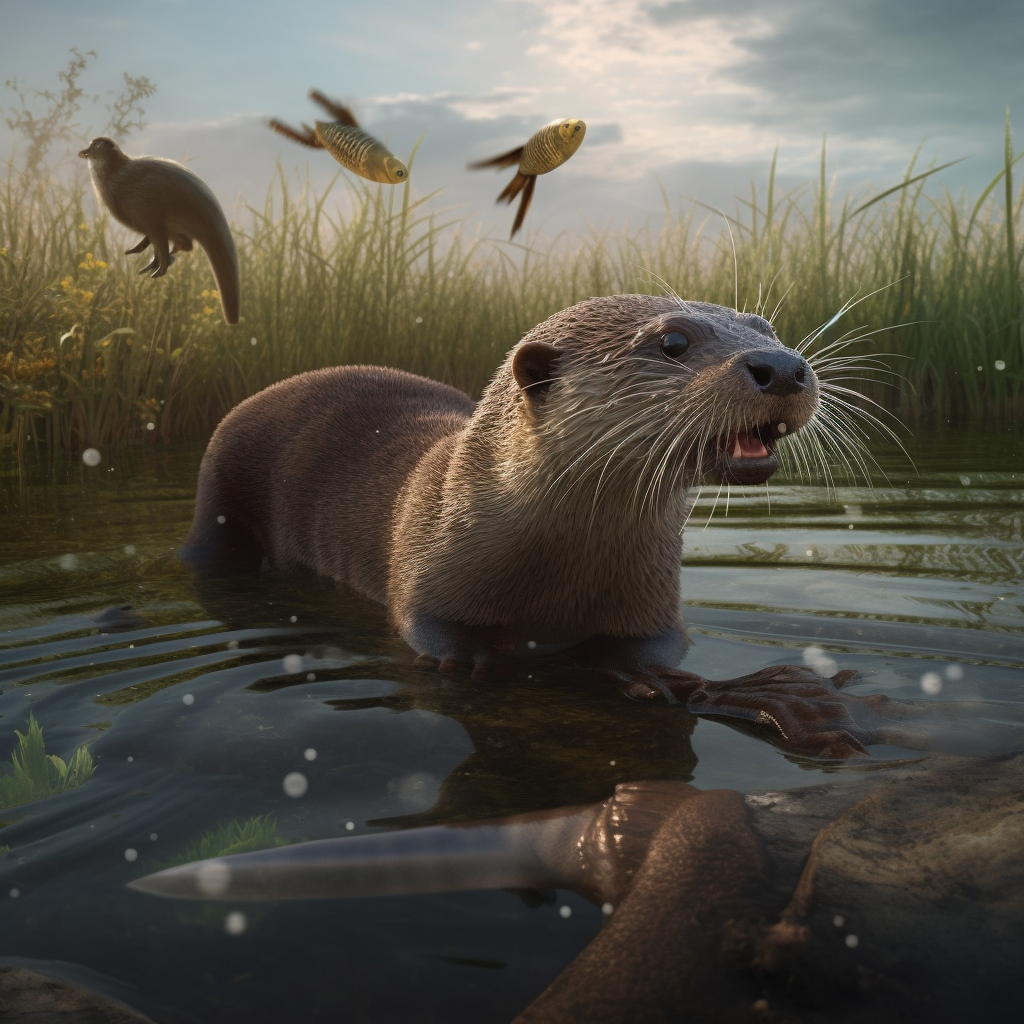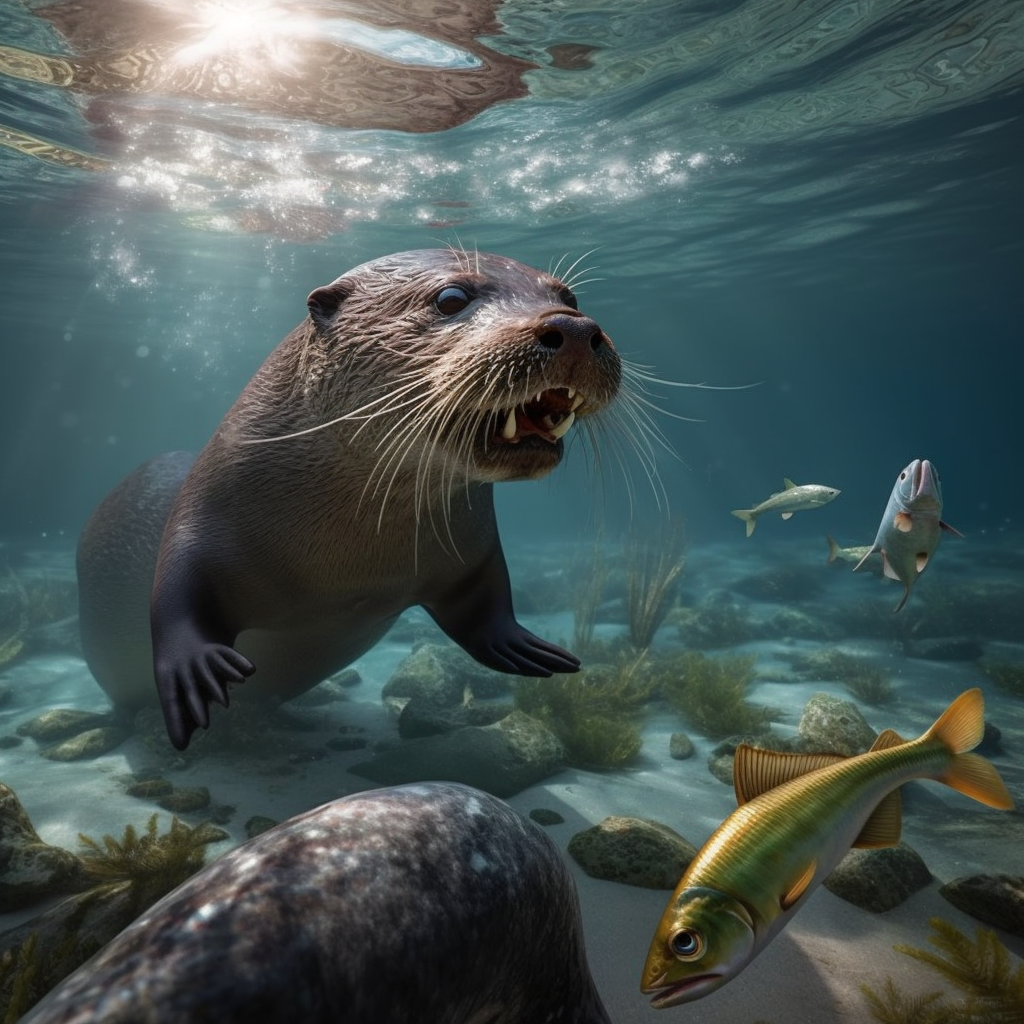River Otters Food Chain
The food chain of river otters is a fascinating ecosystem that showcases the interconnectedness of various organisms in their natural habitat. River otters, also known as North American river otters, are semi-aquatic mammals that inhabit rivers, lakes, and wetlands across North America. These playful creatures are at the top of their food chain and play a vital role in maintaining the balance of their ecosystem. In this article, we will explore the different components of the river otters’ food chain, including their diet, predators, and the impact they have on their environment. So, let’s dive in and discover the intricacies of the river otters’ food chain.
Key Takeaways
- River otters play a crucial role in the food chain as both predators and prey.
- They primarily feed on fish, but also consume amphibians, crustaceans, and small mammals.
- River otters help regulate fish populations and maintain the health of aquatic ecosystems.
- Pollution and habitat loss pose significant threats to river otter populations and their food sources.
- Conservation efforts are necessary to protect river otters and ensure the stability of their food chain.
Understanding River Otters: An Overview

A. The Habitat of River Otters
River otters are fascinating creatures that inhabit various aquatic ecosystems, including rivers, lakes, marshes, and coastal areas. They are highly adaptable and can be found in both freshwater and marine environments. Let’s take a closer look at the habitat of these playful and resourceful animals.
1. Freshwater Habitats
River otters are primarily associated with freshwater habitats, such as rivers and streams. These water bodies provide them with an abundant supply of food and shelter. Otters are excellent swimmers, thanks to their streamlined bodies, webbed feet, and muscular tails. They can navigate through the water with ease, diving and resurfacing effortlessly.
2. Coastal Areas
In addition to freshwater habitats, river otters can also be found in coastal areas, including estuaries and saltwater marshes. These areas offer a diverse range of food sources and provide a unique environment for otters to thrive. Coastal otters have adapted to the challenges posed by saltwater, such as dealing with tides and waves.
3. Shelter and Dens
River otters require suitable shelter to rest, breed, and raise their young. They often create dens in riverbanks, hollow logs, or abandoned burrows. These dens provide protection from predators and extreme weather conditions. Otters are known to be territorial, and they mark their territories with scent to communicate with other otters.
B. Physical Characteristics and Adaptations
River otters have a set of physical characteristics and adaptations that enable them to survive and thrive in their aquatic habitats. Let’s explore some of these unique features.
1. Streamlined Body
The body of a river otter is elongated and streamlined, allowing it to move swiftly through the water. Their sleek shape reduces drag, enabling them to swim efficiently and catch prey with agility. This adaptation is essential for their hunting success.
2. Webbed Feet
One of the most distinctive features of river otters is their webbed feet. The webbing between their toes acts as paddles, providing excellent propulsion in the water. This adaptation allows otters to swim quickly and maneuver effortlessly, making them formidable hunters.
3. Thick Fur
River otters have a dense layer of fur that helps insulate their bodies and keep them warm in cold water. Their fur consists of two layers: a waterproof outer layer and a soft, insulating underlayer. This adaptation allows otters to maintain their body temperature and stay comfortable in various aquatic environments.
4. Sharp Claws
River otters have sharp, retractable claws that they use for various purposes, such as catching prey, climbing, and digging. These claws are essential tools for their survival and enable them to navigate their habitat effectively.
5. Excellent Swimmers
River otters are highly skilled swimmers, capable of diving to great depths and staying underwater for several minutes. They can close their nostrils and ears to prevent water from entering, allowing them to hunt underwater without any hindrance.
In conclusion, river otters are fascinating creatures that have adapted to thrive in a variety of aquatic habitats. Their streamlined bodies, webbed feet, thick fur, sharp claws, and swimming abilities make them well-equipped for their life in the water. Understanding their habitat and physical characteristics is crucial for appreciating the vital role they play in the ecosystem and the intricate dynamics of the river otter food chain.
The Food Chain: A Basic Concept
A. Definition and Importance of a Food Chain
A food chain is a fundamental concept in ecology that helps us understand the flow of energy and nutrients through an ecosystem. It depicts the transfer of food energy from one organism to another, forming a linear sequence of who eats whom. In the case of river otters, their food chain is an integral part of the intricate web of life in aquatic ecosystems.
The importance of understanding food chains lies in recognizing the delicate balance that exists within ecosystems. Every organism, from the smallest to the largest, plays a crucial role in maintaining the overall health and stability of the ecosystem. By studying the food chain, scientists can gain insights into the dynamics of trophic levels, the interactions between different species, and the overall functioning of the ecosystem.
B. The Role of Each Organism in a Food Chain
In the river otter’s food chain, various organisms contribute to the otter’s diet and are influenced by its presence. Let’s take a closer look at the key players in this intricate web:
-
Fish: Fish are a primary food source for river otters. They are an essential part of the otter’s diet, providing the necessary nutrients and energy for their survival. Common fish species consumed by otters include trout, salmon, and catfish.
-
Crustaceans: River otters also feed on crustaceans, such as crayfish and crabs. These small aquatic creatures serve as an additional source of protein and nutrients in the otter’s diet.
-
Amphibians: Frogs, toads, and salamanders are among the amphibians that river otters prey upon. These creatures contribute to the otter’s diet, adding diversity to their food sources.
-
Mollusks: River otters have a taste for mollusks, including clams, mussels, and snails. These shelled creatures provide a source of calcium and other minerals, contributing to the otter’s overall nutritional needs.
It’s important to note that river otters are not only consumers but also part of the food chain themselves. They have predators, such as larger carnivorous mammals and birds of prey, which play a role in regulating the otter population and maintaining the balance of the ecosystem.
Understanding the different organisms involved in the river otter’s food chain helps us appreciate the complexity of the aquatic food web and the interdependence of species within it. By studying these relationships, scientists can gain insights into the overall health of the ecosystem and the impact of changes in the food chain on aquatic biodiversity.
In conclusion, the food chain is a crucial concept in ecology, providing insights into the flow of energy and nutrients within ecosystems. The river otter’s food chain is a fascinating example of how different organisms interact and depend on each other for survival. By studying and understanding these dynamics, we can work towards maintaining the delicate balance of our aquatic ecosystems and preserving the rich diversity of life they support.
River Otters in the Food Chain: A Detailed Examination
A. River Otters as Predators
River otters play a crucial role in the intricate web of life within aquatic ecosystems. As carnivorous mammals, they are skilled hunters and occupy an important position in the freshwater food web. Let’s take a closer look at how river otters function as predators and contribute to the balance of their ecosystem.
1. Otter Diet
The diet of river otters primarily consists of fish, making them an integral part of the aquatic food chain. They have a diverse palate and consume various species of fish, including trout, salmon, and catfish. These fish provide the otters with the necessary nutrients for their survival and growth.
In addition to fish, river otters also feed on a wide range of other aquatic organisms. Crustaceans, such as crayfish and crabs, are a common delicacy for otters. These small creatures are an excellent source of protein and contribute to the otters‘ overall diet.
2. Amphibians and Invertebrates in Otter Diet
Amphibians, such as frogs and salamanders, are also part of the river otters’ menu. These creatures are abundant in freshwater habitats and serve as a supplementary food source for otters. By preying on amphibians, otters help control their population and maintain a healthy balance in the ecosystem.
Invertebrates, including mollusks and various aquatic insects, are another important component of the otters‘ diet. These small organisms provide otters with essential nutrients and contribute to the overall biodiversity of the ecosystem.
B. River Otters as Prey
While river otters are skilled predators, they are not invincible. They have their own set of predators and face certain risks within their environment. Let’s explore the predators of river otters and the challenges they face as prey animals.
1. Predators of River Otters
River otters have a few natural predators that pose a threat to their survival. Large predatory animals such as alligators, crocodiles, and bears may occasionally target otters, especially when they are vulnerable, such as during their time on land or when they are young.
2. Ecosystem Balance
The presence of river otters in an ecosystem is crucial for maintaining a healthy balance. As predators, they help regulate the populations of their prey, preventing any one species from becoming too dominant. This balance is essential for the overall health and stability of the aquatic food chain.
3. Nutrient Cycling in Rivers
River otters also play a role in nutrient cycling within rivers. When otters consume fish and other prey, they excrete waste that contains valuable nutrients. These nutrients, in turn, contribute to the growth of aquatic plants and algae, supporting the entire ecosystem.
In conclusion, river otters are important predators within the food chain of aquatic ecosystems. They consume a variety of prey, including fish, crustaceans, amphibians, and invertebrates. While they face threats from larger predators, their presence is crucial for maintaining ecosystem balance and nutrient cycling. By understanding the role of river otters in the food chain, we can better appreciate the intricate dynamics of aquatic life.
Impact of River Otters on the Ecosystem

A. The Role of River Otters in Maintaining Balance in the Ecosystem
River otters play a crucial role in maintaining balance within the ecosystem they inhabit. As carnivorous mammals, they are an integral part of the aquatic food chain, exerting their influence on various trophic levels. Let’s explore the ways in which river otters contribute to the overall health and stability of their environment.
1. Controlling Population Dynamics
River otters are skilled hunters, primarily preying on fish, crustaceans, amphibians, and mollusks. By regulating the population of these species, otters help prevent overpopulation and maintain a healthy balance within the ecosystem. Their feeding habits ensure that no single species dominates the food chain, allowing for a diverse and thriving community of aquatic life.
2. Nutrient Cycling
As river otters consume prey, they contribute to nutrient cycling in rivers. When otters consume fish and other organisms, they obtain essential nutrients. These nutrients are then released back into the ecosystem through their waste, enriching the water and providing nourishment for other organisms. This process helps sustain the overall health and productivity of the ecosystem.
3. Indicators of Ecosystem Health
River otters are considered bioindicators, meaning their presence or absence can provide valuable insights into the health of an ecosystem. As top predators, they are sensitive to changes in their environment, such as pollution or habitat degradation. Monitoring the population and behavior of river otters can help scientists assess the overall well-being of the ecosystem and identify potential issues that need attention.
B. River Otters and Biodiversity
The presence of river otters in an aquatic ecosystem contributes to the preservation and enhancement of biodiversity. Here are some ways in which these charismatic creatures positively impact the diversity of species within their habitat.
1. Preying on Invasive Species
Invasive species can pose a significant threat to native wildlife and disrupt the delicate balance of an ecosystem. River otters, with their voracious appetite for fish and other prey, can help control the population of invasive species. By targeting these intruders, otters indirectly protect native species and maintain the natural biodiversity of the ecosystem.
2. Creating Habitat Heterogeneity
River otters are known to create dens and burrows along riverbanks, which not only serve as their homes but also provide shelter for other species. These habitats offer refuge to various organisms, including amphibians, reptiles, and invertebrates. By creating habitat heterogeneity, river otters contribute to the overall biodiversity of the ecosystem.
3. Facilitating Nutrient Transfer
River otters are known to transport prey to different locations, often consuming their meals on land. This behavior leads to the redistribution of nutrients from the water to the surrounding terrestrial environment. Nutrients from fish carcasses, for example, can enrich the soil and support the growth of plants and other organisms. This nutrient transfer helps maintain a healthy balance between aquatic and terrestrial ecosystems.
In conclusion, river otters play a vital role in maintaining balance within the ecosystem. Their hunting patterns, nutrient cycling, and impact on biodiversity contribute to the overall health and stability of aquatic environments. By understanding and appreciating the significance of these charismatic creatures, we can work towards preserving their habitats and ensuring the long-term sustainability of our rivers and waterways.
Threats to River Otters and Their Food Chain

A. Human Activities and Their Impact
Human activities have a significant impact on the delicate balance of the river otter’s food chain. As human populations continue to grow and expand into natural habitats, the habitats of river otters and their prey are increasingly threatened. Here are some of the key ways in which human activities affect the river otter’s food chain:
-
Habitat Destruction: The destruction of natural habitats, such as wetlands and rivers, directly affects the availability of food for river otters. When their habitats are destroyed or fragmented, it becomes more challenging for otters to find suitable prey.
-
Pollution: Pollution from various sources, including industrial waste, agricultural runoff, and urban development, can contaminate the water and disrupt the aquatic ecosystem. This pollution can harm the fish, crustaceans, and other prey species that river otters rely on for survival.
-
Overfishing: Overfishing can deplete the populations of fish and other aquatic species that river otters depend on for food. When the prey species decline, it can lead to food scarcity for otters and disrupt the balance of the food chain.
-
Hunting and Trapping: Historically, river otters were hunted and trapped for their fur, which led to a significant decline in their populations. Although hunting and trapping are now regulated, illegal activities still pose a threat to otters and their food chain.
B. Climate Change and Its Effects
Climate change is another major threat to the river otter’s food chain. The warming of the planet and its impact on aquatic ecosystems can have far-reaching consequences for otters and their prey. Here are some of the effects of climate change on the river otter’s food chain:
-
Altered Habitat: Rising temperatures and changes in precipitation patterns can lead to changes in the availability and quality of the otter’s habitat. This can affect the distribution and abundance of prey species, making it more challenging for otters to find food.
-
Shifts in Prey Populations: Climate change can cause shifts in the populations of fish, crustaceans, and other prey species that river otters rely on. Changes in water temperature and nutrient availability can disrupt the balance of the food chain, potentially leading to food shortages for otters.
-
Increased Disease Risk: Climate change can also increase the risk of diseases in aquatic ecosystems. Warmer water temperatures can promote the growth of harmful bacteria and parasites, which can affect both otters and their prey. Disease outbreaks can further disrupt the food chain and impact otter populations.
-
Sea Level Rise: As sea levels rise due to climate change, saltwater intrusion can occur in freshwater habitats, affecting the availability of suitable prey for river otters. This can lead to changes in the composition of the food chain and potentially impact the survival of otters.
In conclusion, human activities and climate change pose significant threats to the river otter’s food chain. It is crucial to raise awareness about these issues and take steps to mitigate their impact to ensure the long-term survival of river otters and the health of their ecosystems.
Conservation Efforts for River Otters
A. Importance of Conservation
River otters play a crucial role in maintaining the balance of aquatic ecosystems. As top predators in the freshwater food web, they help regulate populations of their prey, such as fish, crustaceans, amphibians, and mollusks. By controlling the numbers of these species, river otters contribute to the overall health and stability of the ecosystem.
Conserving river otters is not only important for their own survival but also for the preservation of the entire aquatic biodiversity. These charismatic carnivorous mammals are indicators of a healthy ecosystem. Their presence signifies the availability of suitable habitat and an abundance of prey species. Protecting river otters ensures the protection of the entire food chain and the various trophic levels within it.
B. Current Conservation Strategies and Their Effectiveness
To safeguard river otters and their habitats, various conservation strategies have been implemented. These efforts aim to address the threats faced by river otters and promote their long-term survival. Some of the key conservation strategies include:
-
Habitat Protection: Preserving and restoring the natural habitats of river otters is crucial for their survival. This involves protecting riparian zones, wetlands, and other areas where otters reside. By conserving these habitats, we can ensure the availability of suitable food sources and safe breeding grounds for otters.
-
Pollution Control: Reducing pollution in rivers and water bodies is essential for the well-being of river otters. Chemical pollutants, such as pesticides and industrial waste, can accumulate in otters’ prey and have detrimental effects on their health. Implementing strict regulations and promoting sustainable practices can help minimize pollution and its impact on otters.
-
Sustainable Fishing Practices: Overfishing can deplete the fish populations that river otters rely on for food. By promoting sustainable fishing practices, such as catch limits and habitat protection, we can ensure a stable food supply for otters and maintain the balance of the aquatic food chain.
-
Education and Awareness: Raising awareness about the importance of river otters and their role in the ecosystem is crucial for their conservation. Educating the public, policymakers, and local communities about the significance of otters can garner support for conservation efforts and encourage responsible actions towards their protection.
The effectiveness of these conservation strategies varies depending on the specific circumstances and the level of implementation. However, studies have shown that when these strategies are properly implemented and enforced, they can have a positive impact on river otter populations and their habitats.
In conclusion, conserving river otters is vital for maintaining the balance of aquatic ecosystems and preserving the overall biodiversity. By implementing effective conservation strategies, we can ensure the long-term survival of these charismatic mammals and safeguard the health of our rivers and waterways. It is our collective responsibility to protect and cherish these remarkable creatures for future generations to enjoy. Conclusion
In conclusion, the river otter food chain is a fascinating and intricate system that highlights the interconnectedness of various organisms in their natural habitat. River otters, as top predators, play a crucial role in maintaining the balance of their ecosystems. They primarily feed on fish, amphibians, crustaceans, and small mammals, which are all part of their diet. However, river otters are also preyed upon by larger predators such as alligators and bears. The availability of food sources and the health of the river ecosystem are key factors that determine the survival and well-being of river otters. By understanding and protecting the river otter food chain, we can contribute to the conservation of these remarkable creatures and the preservation of their habitats.
Frequently Asked Questions
What are the main components of aquatic ecosystems?
Aquatic ecosystems are complex habitats that include a diverse range of organisms. These can be broadly categorized into producers (like algae and other aquatic plants), primary consumers (such as mollusks and crustaceans), secondary consumers (like fish and amphibians), and top predators (such as otters and other carnivorous mammals). These components interact with each other and the environment, contributing to processes like nutrient cycling in rivers.
How does the freshwater food web function?
The freshwater food web is a complex system of energy transfer among different organisms. It starts with primary producers like algae, which are eaten by primary consumers (invertebrates and mollusks). These, in turn, are preyed upon by secondary consumers (fish and amphibians). Top predators, like river otters, prey on these secondary consumers. Each of these stages is known as a trophic level.
What does an otter’s diet consist of?
Otters are carnivorous mammals and their diet primarily consists of fish, which makes up the majority of their food. However, they also eat a variety of other aquatic life, including crustaceans, mollusks, and amphibians. The specific composition of an otter’s diet can vary based on the availability of prey in their habitat.
How do fish fit into the food chain as prey?
Fish are an important part of the aquatic food chain. They are typically secondary consumers, meaning they eat primary consumers like invertebrates and mollusks. However, fish are also prey for top predators in the ecosystem, such as river otters.
What role do crustaceans play in the aquatic food chain?
Crustaceans, which include creatures like crabs and shrimp, are typically primary consumers in the aquatic food chain. They feed on algae and other primary producers, and in turn are prey for secondary consumers like fish and amphibians.
How are amphibians involved in an otter’s diet?
Amphibians, such as frogs and salamanders, form a part of the river otter’s diet. While otters primarily feed on fish, they also hunt amphibians when available. This contributes to the diversity of their diet and their role as top predators in the ecosystem.
What are the main predators of river otters?
River otters are top predators in their ecosystem, meaning they have few natural predators. However, they can be preyed upon by larger carnivorous mammals, such as wolves or cougars, and birds of prey like eagles, especially when they are young or ill.
How does aquatic biodiversity contribute to the food chain dynamics?
Aquatic biodiversity, or the variety of life found in water habitats, contributes to the stability and resilience of the food chain. Each species plays a unique role in the ecosystem, whether as a producer, consumer, or decomposer. This diversity ensures a balanced distribution of resources and energy, which is crucial for the health of the ecosystem.
How do river otters’ feeding habits affect the ecosystem balance?
River otters, as top predators, play a crucial role in maintaining the balance of their ecosystems. By preying on species like fish, crustaceans, and amphibians, they help control these populations and prevent them from over-consuming resources. This predatory role contributes to the overall health and balance of the ecosystem.
How does nutrient cycling occur in rivers?
Nutrient cycling in rivers involves the transfer and transformation of nutrients like nitrogen and phosphorus among organisms and the environment. Producers like algae absorb nutrients from the water to grow, and these nutrients are then passed up the food chain when the algae are consumed. When organisms die or excrete waste, decomposers break this material down, returning the nutrients to the water to be used again by producers.




